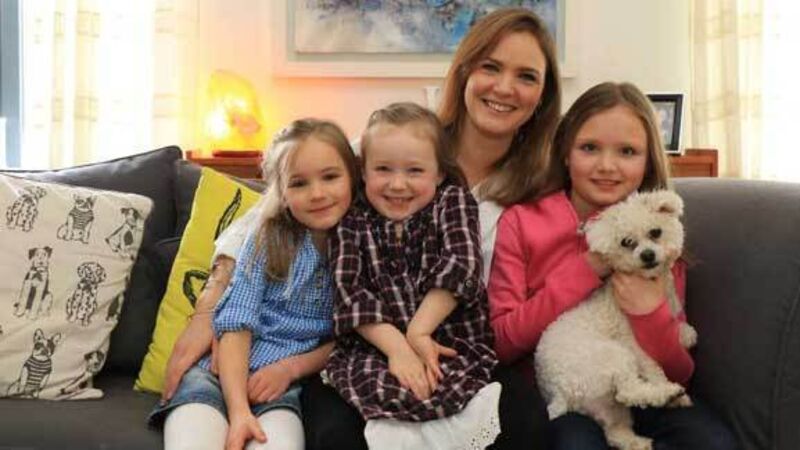How mindfulness can help if you suffer from panic attacks

WHEN Ciara Butler speaks about love and compassion, her three girls say their mum is talking her ‘yoga talk’.
Living in Aughrim, Co Wicklow, the 39-year-old lactation consultant first came across mindfulness in 2009 after the birth of her second daughter, Sophie, now aged seven.
Post-natal depression doesn’t always manifest as black depression, says Ciara, whose other daughters are Lucy, aged nine, and Anna, aged four.
“Sometimes it can manifest as anxiety. I was overwhelmed with the second baby and with everything that’s involved with having two kids.
"I had a panic attack. I’d never had one before. It was on a weekday afternoon. I thought I was going mad.
"I rang Ed, my husband, and said I’m going to bed. I thought I was tired. I woke up next morning and still felt anxious.”
Over the next few months, still suffering panic attacks, Ciara sought help from a homeopath and from a counsellor.
The latter recommended an “amazing book” — When Things Fall Apart by Buddhist nun Pema Chodron.
“It’s about mindfulness and dealing with fears and emotions,” says Ciara.
Her interest sparked, Ciara attended a mindfulness course.
She embraced mindfulness because “it gave me the tools I needed to get through my day”.
It also helped her appreciate the life she had and to be grateful for everything in it.
I began meditating daily for about 10 minutes, focusing on my breath, sitting with whatever came up, even if it was difficult.
"Mindfulness teaches us to sit with the bad stuff, not to always try and grasp and hold onto the good stuff.
"It’s about the middle path, learning to stay even when it’s scary and uncomfortable. The mind wants to go elsewhere, it doesn’t want to stay.
"The more we learn to stay, the less scared we become of ourselves and our emotions.”
Ciara uses a recently-refurbished room in her house as a yoga space, which she practices four or five times a week for an hour or two each time.
“Day to day, I incorporate mindfulness while brushing my teeth or cleaning the kitchen, bringing awareness to the task at hand.
"At times of stress or high emotion mindfulness proves very helpful — noticing the emotion arising, remembering to breathe, feeling my feet on the floor and pausing.”
Ciara says mindfulness helps her cope with the lack of control children bring to one’s life.
“You have your diary full, plans for the weekend and then someone gets sick. Before you have kids, it’s very easy to compartmentalise your life.
"Throw a baby into the pot and it’s impossible to do that. It’s very hard to transition from a controlled life to one where you have no control.
"Mindfulness teaches you to surrender to that and to the moment.”
Now she doesn’t sweat the small stuff (if the children’s clothes aren’t coordinated or if they don’t want to wash their faces before bed).
She picks her battles — she’s firm about kindness, sharing and getting to school on time, but not so fussed when they get mucky in the garden.
“Before, I would have filled every moment with things do to and people to see. Now I need quiet time at home with or without the children.
"I think this is a good lesson for them — to know that we don’t need to be on to the go all the time.”
When it comes to embracing mindfulness, Ciara’s on the same page as many mums nationwide, according to new research from parenting website www.eumom.ie
Almost half (47%) of more than 3,000 mums surveyed say they have learned about mindfulness since the recession.
“One of the stories coming out of the research was the importance of ‘authentic living’. Rather than seeking to ‘make the most of now’, moms are seeking to be present in the now and appreciate the happiness of now,” says an Eumom spokesperson.
Mums practicing mindfulness are also modelling it for their children. Ciara Butler’s daughters are aware of mindful breathing.
“It’s something we try to do when someone’s freaking out. If one of them is worried about something I encourage them to be with the emotion, imagine it’s like a big bubble that can’t hurt them, just to watch, observe and then gently pop it and it will go away. [I encourage them] to do this whenever something comes up.
“Kids live most of their lives in the present moment so mindfulness comes easy.
"It’s very reassuring for them to be reminded that yesterday has gone and tomorrow hasn’t happened — therefore right now is all we need to worry about and right now everything’s fine.”
It’s weather — but not in quite the limited way we know it.
Irish Weather Inside-Out is an invitation to mindfulness, to observe change using the ever-changing image of Croagh Patrick in County Mayo.
The invitation is to sit for a few moments twice daily up to March 17, using the images of Croagh Patrick on Mindfulness Matters Facebook page (Mindfulness Matters Mayo), Twitter (@infomindfulness) and blog http://www.mindfulnessmatters.ie/blog.html taken by Westport photographer Michael Gannon.
The idea is the brainchild of Derval Dunford and Dr Ann Caulfield of www.mindfulnessmatters.ie
Bressie is supporting the challenge via his website A Lust for Life and on social media.
Participants take some moments each morning, with the image of Croagh Patrick recorded at sunrise, to observe the external weather.
They then consider their own internal weather at that moment — their feelings and emotions.
“You can sit quietly, solid like a mountain, aware of your body, aware of your breath,” explains Dunford.
In the evening, participants take some moments to observe once more, by viewing the sunset image of Croagh Patrick — then check in on their own internal weather.
“We invite you not only to observe your internal weather and the transient nature of thoughts, emotions and clouds but also to report to us on Facebook/Twitter using a word or an icon.”
Becoming aware that we are not our thoughts or emotions allows us to sit and observe them as they come and go.
“We may begin to notice their transient nature, similar to the weather and clouds in the sky. We can experience happiness, sadness, peace and more, all in one day.
"Emotions come, linger for a while and change. None of them will stay forever. Learning not to grasp happiness, learning not to push sadness away reduces our suffering,” says Dunford.
* Irish Weather Inside-Out is available to schools nationally on the Mindfulness Matters Blog http://www.mindfulnessmatters.ie/blog.html with guidelines for use in the classroom.











